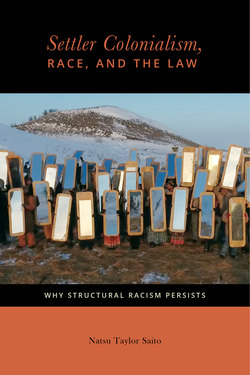Читать книгу Settler Colonialism, Race, and the Law - Natsu Taylor Saito - Страница 34
На сайте Литреса книга снята с продажи.
Direct Killing, or Officially Sanctioned Massacres
ОглавлениеDespite the early British colonists’ claims that the lands they intended to occupy were “not inhabited,”18 the Eastern Seaboard—indeed, all of North America—was well populated by Indigenous peoples, who were driven from their lands only with considerable effort.19 The Virginia Company established the Jamestown Colony in 1607 and recruited settlers by offering them land grants.20 By 1610 the colony’s aptly named governor Thomas West De la Warr had initiated military campaigns to counter the Algonquin leader Powhatan’s “prowde and disdaynefull” attitude toward these settlers, launching attacks in which Indians were indiscriminately killed, entire villages burned, and crops destroyed. According to American studies professor David Stannard, from that point forward “the only controversy” among the colonists was “whether it was preferable to kill all the native peoples or to enslave them.”21
By 1622 over eighty English settlements extended along the James River, deep into Algonquin territory.22 Faced with the settlers’ refusal to recognize or respect Indian life or property, Powhatan’s successor Opechancanough countered the invasion by attacking outlying settlements. To the English, this was a “barbarous massacre.”23 It could not be a legitimate defense of the Indians’ homeland because, in the settlers’ estimation, those without land rights or sovereignty could not wage a legitimate war. Rather, as noted in The Records of the Virginia Company, “the treacherous violence of the savages” gave the English a “right” to “invade the country and destroy them who sought to destroy us.”24 British tactics included the deceptive use of peace treaties, mass poisonings, the deployment of dogs to hunt and kill people, the kidnapping and holding hostage of Indian children, the burning of villages, and the destruction of crops, canoes, and other means of livelihood.25 By 1700 there were over sixty thousand English settlers in the mid-Atlantic region and perhaps six hundred Algonquins.26
Similar tactics were employed throughout the Northeast. Between 1636 and 1638, troops from the Massachusetts and Plymouth Colonies waged a war of extermination against the Narragansetts and Pequots. In one raid alone, some seven hundred Pequots were burned to death; their “frying in the fire and the streams of blood quenching the same” deemed a “sweet sacrifice” by William Bradford, five-term governor of the Plymouth Colony.27 Survivors were hunted down and killed or sold into slavery. Thereafter, even the word “Pequot” was banned, removed from landmarks and from maps. “Having virtually eradicated an entire people, it now was necessary to expunge from historical memory any recollection of their past existence.”28 These were prototypical, not exceptional, events in American settler colonialism; in the histories of the Jamestown, Plymouth, and Massachusetts Colonies, we see a template that would be utilized in the occupation of North America over the next 250 years.29
British attempts to limit the colonizers’ territorial expansion, particularly the Royal Proclamation of 1763, prohibiting settlement west of the Allegheny and Appalachian mountains, provided a major impetus for the war for independence.30 As Seneca historian Barbara Alice Mann documents, the western front of the American “revolution” was fought primarily against Indigenous nations, not the British.31 The Iroquois League, for example, had long endeavored to remain neutral, but its lands were squarely in the path of American expansion. Thus, in 1779 George Washington sent some five thousand troops to destroy forty-one Iroquoian towns, from New York through Pennsylvania to eastern Ohio, with explicit instructions not to “listen to any overture of peace before the total ruin of their settlements is effected.”32 In other words, the objective was not the colonists’ security but the acquisition of land.
After formal recognition of their political independence, American leaders continued to “clear” the lands they claimed from coast to coast. While these wars were frequently described as “exterminating the hostiles,” Indigenous people did not need to be “hostile” to be attacked and driven from their lands.33 In November 1864, for example, an all-volunteer regiment in the Colorado Territory attacked a village of sleeping Cheyenne and Arapaho noncombatants who had placed themselves under US military protection at Sand Creek. Well over a hundred people were simply slaughtered, their bodies mutilated, and their “private parts” exhibited as trophies as the regiment paraded through downtown Denver to the cheers of the citizenry.34 In December 1890, Wizard of Oz author Frank Baum opined that “the Whites . . . are masters of the American continent, and the best safety of the frontier settlements will be secured by the total annihilation of the few remaining Indians.”35 Just a week later, more than three hundred unarmed Minneconjou Lakotas were massacred at Wounded Knee, South Dakota, and the “frontier” declared closed.36
